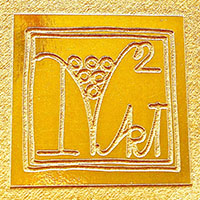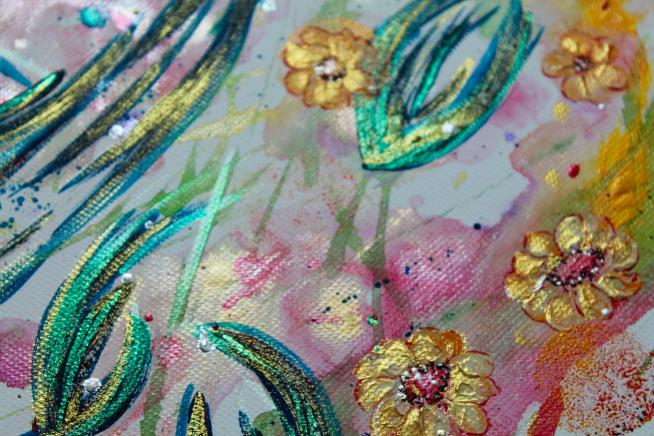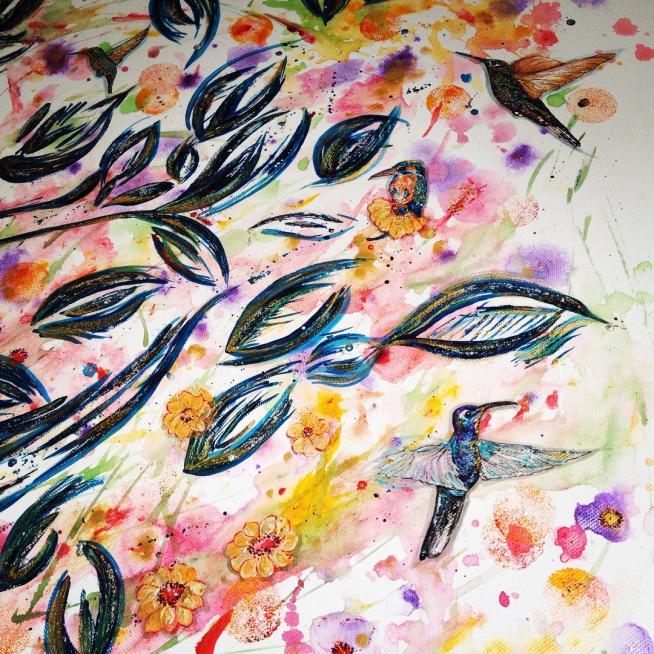Judit Nagy L. was born in Bucs, a small village in Slovakia. Her native language is Hungarian. She started drawing at a very early age. Her schoolteacher was the first one to acknowledge her painting skills and see her talent, recommending she follow her passion. Her brother played a big role in the decision to continue, supporting her daily.
Judit earned a Master in Civil Engineering. However, she still felt like something was missing from her life.
The emptiness she felt, pushed her to make a decision for her 40th birthday – to do a pilgrimage called El Camino de Santiago. Just like in movies, walking that trail for 42 days changed her forever: she fell in love with wine, met her husband Stefan and gathered the courage to pursue her passion to paint again. Today she lives and works in Switzerland (Freienstein, canton ZH) having created her own unique mixed media process of painting with wine, resonance gouache or acrylic dyes carrying homeopathic informations, using real crystals and perl-acrylic colors with extreme high pigmentation.
LNJ
Since then she has been transforming her passion as a wine painter, wine taster and wine jury by showcasing her feelings for wine in a surprising and wondrous way. She preferes to capture the character, the peculiarity, the “fluid history” of the wine as well as her personal sensory impressions in her works.
Judit invented her IVVArt Method © in 2015 and called it “IVVArt – In Vino Veritas Art Method“. The final “product” changes with light, due to this constant change, each piece carries a distinctive message, depending on the time at which it was produced.
LNJ is a member of SIK-ISEA and a newcomer at Visarte Switzerland.
“For me, selling my artworks is more than just a simple dealer act – I give my customers the exclusive rights to a life of personal enjoyment” – Judit Nagy L..”
1.000 km
Judit’s journey of self-transformation. Camino de Santiago 2011. 2 million steps. 35 days. Traveling to the notorious end of the world (Finisterra). 3 wine regions: Rioja/Navarra, Castilla y León and Galicia. The path from zero to hero.
+100
Paintings 60 wine paintings, +10 authentically certified WINEporTRAITs, +20000 photos, +1500 hours of work. 5000 hours spent in nature. All of this, 8 years after the Camino. She walks before she talks. Step by step.
Meet Judit Nagy L
1. Tell us why you decided to become an Wine Artist?
My wine painting journey started 8 years ago, shortly after I walked the Camino in 2011. So much learning was done and knowledge was acquired from the errors and mistakes I made along the way. These instances have helped me solidify my skill set, I’m looking forward to seeing what the next 8 years hold! My most important goal is to project into my images the deepest structures and wonders of the created world which exist „written“ in wine. By my WINEporTRAIT- s I’m looking not only for the complexity of the wines, but I am seeking for the ‘truth’ that touches us in wine. There is the chance of a heart-touching encounter when one is open to receive the message expressed by the real wine. I want to warmly touch a viewer’s heart and soul.
2. What kind of artist do you consider yourself?
The most important question for me is this: how can I stay constantly intuitive?
The intuitive way allows me to get to the centre of the picture without distraction. Walking this road reminds us that we are only the messengers, we carry the energy we invite openly and express it to others. The intuition-based track is a path of trust, faith and love that I want to “express” based on my impressions. I think that this kind of visual proclamation fits in well with Abstract Expressionism.
3. Do you have any mentors or advisors?
I had mentors and advisors during the searching phases which means during 2014, 2015
and 2016. Currently I have had some consultations and workshops with experts in chemistry, wine and art.
4. How is your artistic process when creating work?
Usually I paint with acrylic on canvas or wooden boards. My favorite paints are the swiss made acrylic dyes, which include bioresonance informatin. I will explain the three art methods I typically use. Firstly, Acrylic or mixed media with acrylics dyes on canvas (or wooden panel). Secondly, Winepaintings where I use wine ustead of water, or I mix my IVVArt past with all components without mentioning information about the the wine and its winemakers. Finally, my real speciality, the wine paintings, for which I developed an IVVArt Method and they are named WINEporTRAITs. Why? While they are portraits of the wines I tasted I felt the stories for them;they inspire me to tell a visual story about how I see and feel the. It is similar to the photographer’s work, when one has to feel the client’s essence to take ‘the’ photo, to make ‘the’ portrait mirror the deepest and purest thoughts or character of the subject/object.
How does it work?
During the last two years I became aware, that there are tow main ways for me to create WINEporTRAITs:
The first one is when I ‘meet’ the wine- it is a direct contact, spontaneous or as a result of a search to get a special sort of bottle and then I taste it, I analize it, I make sketches and/or notes or start directly without any of them to mix an IVVArt paste and paint very spontaneoulsly.
The second one is somehow very similar to a person with a huge desire to have a child, but he/she needs to find the prefectly matching partner for the ‘project’. In his/her heart and mind there is a-yet not finished, plasti- projection of a wished, dreamed and beloved child he/she is carrying within the whole time. So it happens sometimes, I see something that inspires me to make a sketch and I have to wait till I meet the right wine that it matches the story I hold in my mind. Then the desire meets the perfect wine and the dance comes out in a new WINEporTRAITs.
Both creative ways are very exciting, but hold their own challenges.
5. Name three artist you admire.
I admire very much:
1. Victor Vasarely (ungarisch: Vásárhelyi Győző), was a French painter and graphic designer with Hungarian roots. He is one of the co-founders of the artistic direction Op-Art. Victor Vasarely studied in Budapest at the Podolini-Volkmann Academy. Later, he attended the Mühely School of Graphic Arts, run by Sándor Bortnyik in the tradition of the Bauhaus.
2.Tivadar Kosztka Csontváry was a Hungarian painter who painted figurative pictures in expressive colors. By profession he was a pharmacist, however, he followed an inner inspiration at the age of 41 years, which was to become a painter. He toured countries such as Palestine, Lebanon, Sicily, Greece, Bosnia and Egypt, from where he brought with him a variety of impressions, which he artistically processed for his pictures, especially landscapes. He is not really regarded as a naive painter, because he, despite naive echoes, developed his painting in expression and composition to high mastery. Some of his pictures have monumental formats of up to 4 by 7 meters and are attributed to Expressionism, but also contain elements of Post-Impressionism. Many painters who became aware of his art, e. g. Picasso, who gave him great recognition.
3. Zhuang Hong b. 1962 China. I am in love with his large and ever larger floral compositions full of plasticity, which he mainly creates. “Zhuang Hong Yi embracing his present without losing his past, he attempts to define a sense of self that exists between the two. Zhuang enacts this personal struggle visually, vacillating between phases of controlled planning, emotional gesture and careful editing, creating works that represent beauty, sophisitication and perfection.“
In 2015 Judit spent a season harvesting and making wine in Winterthur wine region
Neftenbach, Switzerland.
6. Have you overcome any challenges in your career?
My biggest challenges in my art career I had to overcome were and are caused by painting with my IVVArt © wine paste.
7. Has gallery representation always been your dream or working independently been more beneficial? Or both?
There are so many platforms now for artists living in obscure or out-of-the way places to get their work out and be seen. But truth is, not any one person can “make” an artist. Art is a mysterious process, and who the influencers are changes.
Gallery representations are important, they build one’s reputation; but they are sometimes
very expensive for artists. Working independently is an another way, which also fosters problems, in the sense that you have to manage everything about your art business on your own. Gallery representation in comparison to independent work – both are useful if all involved in the art fair as potential customers and art lovers benefit from it.
8. Tell us one of the weirdest or funniest moments of your career.
Weird and intimate moments were to be involved into some viewers on the spot and authentic reactions to my pictures. I was blessed to see the very emotional effect caused by my blue hummingbird series from 2017, the “Dancing Dervish”, the “Lemuria”, “Brother Sun, Sister Moon” or “The Phoenix`s Dance”.
9. What advice would you give to an emerging artist?
It’s hard to tell an artist that this or that will certainly be the “right” process to be recognized as an emerging artist. The best thing we all can do is make our art, have the contacts and be ready and open to possibilities. Network.Travel. Find other artists to be able to talk to. We are isolated in our studios, galleries, there’s no one to talk to, no one to get that critical feedback from.
10. As you reflect, what have been the influencing factors in your Art career?
I had many influencing factors in my art career: my childhood, my family and friends, my
mentors from art schools and private sessions, my motherhood, my lovers and the nature.
I have formulated it in my previous elevator speech, I am a wine painter and degustator who adds a sense of surprise and whimsy in my artwork. My passion is capturing the personality of every wine while creating the very personal visual story of every liquide history. I am a photographer too, in search of capturing light with a high sensibility for details, focused mainly on nature. Trees, sky, water drops, dandelions and hummingbirds are my favorite theme.
Furthermore, Judit paints with acrylic as well as bio-resonance colors. Her works are colorful and
collage-like, you will find objects such as earth, bird feathers, crystals, shells or mirrors in their
pictures
Photos copyright by: Judit Nagy L






